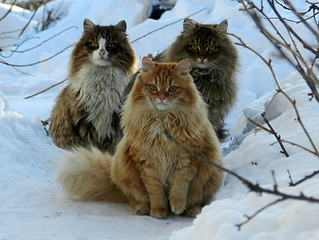
Siberian Morphology
A breed with a singular, natural archetype
It's no easy task to precisely define the archetype of the Siberian cat, as its history and appearance have followed sometimes divergent paths. Today, there are a large number of so-called "Siberian" cats, some the result of natural selection, others shaped by rigorous breeding.
One of the main challenges lies in the diversity of standards defined by the major international feline federations, each of which recognised the breed at different times, with their own interpretation of its development.
Unlike other breeds such as the Norwegian or Maine Coon, whose standards were established by professional felinologists, the first criteria for the Siberian were the result of a consensus between Soviet breeders, who were often untrained. Even today, it is not uncommon to come across stray Siberian cats in Moscow or St Petersburg, wrongly considered to be mere alley cats.
But behind this apparent diversity lies a true identity: that of a cat originating from the remote areas of Siberia and the Russian Far East. This harsh natural environment has shaped a robust, genetically stable feline with well-defined characteristics. It is by capturing these constant traits that breeders have been able to set the standard.
So it was the combination of harsh natural selection and the gradual recognition of its most stable traits that enabled the Siberian to become a breed in its own right, and not just a population of hardy domestic cats.






Alla LEBEDEVA and her husband Sergey live on a farm in the Prigorodny raion in Siberia, where they keep hens and cats to protect the poultry from rats and mice - Photos: Alla Lebedeva.
Sources: https://positivr.fr/chats-ferme-siberie-alla-lebedeva/?utm_source=ActiveCampaign
The Siberian's criteria according to the LOOF
The Coat: A Protective Triple Layer
The Siberian's coat is medium-long, dense and structured into three types of hair:
-
Topcoat: long, thick, straight and slightly spatulate at the tip. They provide protection from the weather and are found mainly on the back, shoulders and tail.
-
Guard hairs (intermediates): also insulating, they have an angled tip and a firm texture.
-
Undercoat (down): short, soft and very dense, it provides optimum thermal insulation. This coat helps to hide the Siberian's powerful bone structure, while protecting it from the extreme cold.


The head: a distinctive geometry
This is one of the Siberians' most distinctive features compared with other long-haired breeds. The head is trapezoidal, well proportioned to the rest of the body. The bottom of the trapezoid corresponds to the line of the eyes and the bridge of the nose, while the top follows the width of the whisker pads.
-
Muzzle : Well defined, slightly pointed, neither too broad nor too fine.
-
Cheekbones : Full, harmonious, well integrated into the profile.
-
Chin : recessed, called "gently sloping".
-
Thighs: Long and thick, reflecting hunting instinct.
-
The ideal proportions of the face (nose, eyes, chin) are almost equal, giving the Siberian a very balanced and wild expression. The length of the muzzle (D1), the length between the nose and eyes (D2) and the length of the chin (D3) are virtually identical.


Inata from the Cousse Valley - Neva Star Cat
Description of facial morphology
Inter-Race Comparison
Description of facial morphology
The Eyes : Expressive and Oblique
Neither round nor almond-shaped, the Siberian's eyes are slightly oblique, with an upper lid that is shorter than the lower, stretching to a pointed tip.
Ears: balanced and rounded
The ears follow the line of the skull, pointing slightly forward. Their height and spacing between the ears are equivalent to 1 to 1.5 times the width of their base. Lynx tips are very popular.
The body : powerful and massive
Semi-foreign in shape, the Siberian's body is reminiscent of a muscular barrel :
-
Chest and neck: broad.
-
Back: long, slightly arched, but level when walking.
-
Tail: thick, bushy, broad at the base then tapering.
Growth is slow: bones develop up to 3 years, muscle mass up to 5. Males weigh between 6 and 12 kg, females between 4 and 6 kg. In winter, their weight is higher and their fur denser.
Legs: strong and adapted to snow
The legs are robust, with slightly longer hind legs. Their feet are large and round, with a lot of hair between the toes for walking in the snow.
Character: a sociable, playful and loyal feline
As with children, every Siberian has its own temperament, but the breed is generally lively, curious and sociable. They need space to express themselves, especially if they live indoors: large cat trees, toys, hunting games...
Very communicative, they often follow their humans from one room to another and love to take part in their daily activities. He also craves a good dose of cuddles - whether given or received! Once they've been socialised at a young age, they do very well with other animals.
Some even learn to walk on a lead or fetch a ball like a dog!





